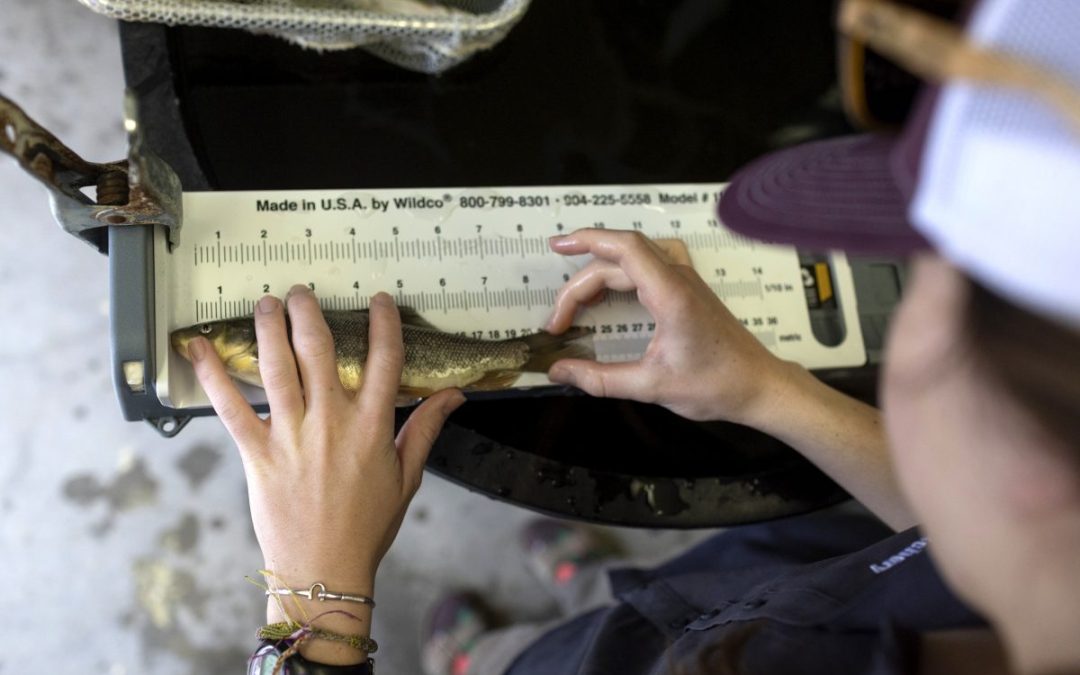PALISADE — With squeals, shrieks and plenty of peer pressure, Palisade High School students lined up to release endangered razorback suckers — with a kiss for good luck — into the Colorado River.
“Grab a fish, kiss it, put it in the river,” Charlotte Allen, 18, a senior at the high school, told amped up students as they prepared to hold the slippery fish.
The school’s endangered fish hatchery, which began in 2020, released its thousandth razorback sucker Friday during its annual release celebration. The program is part of a greater effort to restore populations of the native fish — an effort that helps pull water west in Colorado to benefit ecosystems, farmers, communities and industries along the Colorado River.
For the students, it’s a way to pursue scientific research, connect with their environment and even test out future careers.
“Raising these fish during my four years at Palisade High School has opened my eyes to a whole new world of conservation,” Kale Potter, 17, a Palisade senior and hatchery technician, told a crowd of more than 200 students, community members, wildlife officials, parents and teachers.
Almost a decade ago, Mike Gross, a fish culturist with U.S. Fish and Wildlife, brought the idea of creating a school-based hatchery to science teacher Pat Steele, and the two spent five years planning it out. Eager students sold peaches and local organizations came together to raise enough money to start the program. The hatchery tanks were filled with their first batch of fish in August 2020.

Four years later, biologists are finding razorback suckers raised at Palisade High School among other fish at spawning locations — a positive sign as wildlife managers try to boost the species’ population to sustainable levels.
“I think the more we’re able to get students outside and the more that we’re getting them in touch with our natural surroundings is important,” Steele said. “That’s always been a goal of mine.”
The beloved, opportunistic slime-sucker
Razorback suckers have lived in the Colorado River Basin for 5 million years. Now, the species is on the federal endangered species list with a population of almost 58,000 spread around the overstressed Colorado River Basin.
Razorbacks, named after the bony spine behind their eyes, are opportunistic omnivores, eating dead fish and slurping up slime like little vacuums that constantly clean the water. They can grow to 40 pounds and migrate hundreds of miles around the 246,000-square-mile river basin, which spans seven Western states including Colorado.
“They’re not like a little suckerfish in your aquarium. They’re like puppy dog-size,” said Mike Gross, educational outreach manager at the Ouray National Fish Hatchery – Grand Valley Unit.

In millenia past, the gushing Colorado River formed floodplain wetland habitats. Young razorbacks, often born around Easter, found refuge from these fast-flowing rivers in the backwater areas.
Now, those wetlands are not as plentiful, in part because of human uses that have developed the areas, dammed the river or diverted its flows. Nonnative predator fish, like the smallmouth bass and northern pike, also flourish in warmer waters and seek out backwaters, where they have a never-ending supply of young razorbacks to eat.
In response, water officials have set up statewide programs, like the Upper Colorado River Endangered Fish Recovery Program, that work across the basin to boost populations of razorbacks, along with the endangered bonytail and Colorado pikeminnow.
Farmers, reservoir operators, city water managers and conservationists across Colorado coordinate their water plans to try to improve conditions for the species. One species, the humpback chub, was restored enough that it was downgraded from endangered to threatened.

These water management plans also help ensure that Colorado River water continues to flow through western Colorado — instead of being used elsewhere — supporting agriculture and communities along the way.
“The big hurdles in recent years are the nonnative fish,” Gross said. “It seems like if there wasn’t such a problem with the nonnative fish … we might be able to have better long-term success.”
“I came for the fish”
The students working at the Palisade Fish Hatchery are helping bring back the razorback.
A week before the big day, students rotated through the hatchery, a brick outbuilding and former shed, to check tracking tags and take the final weight and length measurements for the fish.
They called out numbers over the hum of pumps and chatter of other students to record the measurements in a national database. This year, the students went to a federal fish hatchery to help spawn the fish, by mixing eggs and sperm in Ziploc bags. In the fall, the fish were months old and about 2-inches long.
The largest of the now 1-year-old fish, named Walter, measured in at 11 inches and less than 12 ounces.
“We watched these guys get conceived, then we watched them hatch and we’re watching them get released,” Potter said.

Palisade High School teacher Patrick Steele chats with students in a river dynamics class before they measure and weigh the fish inside the school small hatchery building. (Photos by Hugh Carey, The Colorado Sun)
The hatchery exposes the students to new experiences, from raising fish to operating water pumps and changing filters. Experiments in the hatchery function as final projects for courses. One student experimented with how changing light patterns impacts fish growth, and another studied fish growth in indoor versus outdoor hatcheries.
Kiera Stephen, a 17-year-old senior and hatchery technician, experimented with types of fish food as a final project for her biology class.
“I came for the fish — and I love the fish — but I’ve also really grown to love the technical aspect of it as well,” said Stephen, who wants to pursue a career in freshwater biology. Plus, the fish can live for 40 years. “I could be 50 years old, and Walter could still be out there.”
The release event Friday featured hundreds of people, media crews and even Jeff Corwin, a biologist, wildlife conservationist and television personality, known for shows like Disney Channel’s “Going Wild with Jeff Corwin.”
“(These students) get to immerse themselves in this life changing experience, not only changing their lives, but contributing to the ecosystem to ensure that this watery web of life … thrives through future generations,” Corwin told the crowd.
The event, and the show of community support, never failed to blow her away, Stephen said. Steele thanked the partners who came together for the sake of the Colorado River.
For Gross, it was part of a larger hope. He wants communities and younger generations to see these “trash fish” as unique, refined animals.
“A lot of folks might not even know about a razorback sucker or care about them,” he said, “but when they see the next generation that’s genuinely invested in these animals, that are learning — that have raised these fish, that have put them out with their blood, sweat and tears, literally — it makes the whole town come together for conservation.”



 Print
Print